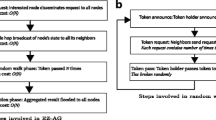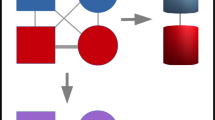Abstract
This paper describes Census, a protocol for data aggregation and statistical counting in MANETs. Census operates by circulating a set of tokens in the network using biased random walks such that each node is visited by at least one token. The protocol is structure-free so as to avoid high messaging overhead for maintaining structure in the presence of node mobility. It biases the random walks of tokens so as to achieve fast cover time; the bias involves short albeit multi-hop gradients that guide the tokens towards hitherto unvisited nodes. Census thus achieves a cover time of O(N) and message overhead of \(O(N\,log(N))\) where N is the number of nodes. Notably, it enjoys scalability and robustness, which we demonstrate via simulations in networks ranging from 100 to 4000 nodes under different network densities and mobility models. We also observe a speedup by a factor of k when k different tokens are used (\(1 \le k \le \sqrt{N}\)).













Similar content being viewed by others
References
Alon, N., Avin, C., Koucky, M., Kozma, G., Lotker, Z., & Tuttle, M. R. (2008). Many random walks are faster than one. In Proceedings of the twentieth annual symposium on parallelism in algorithms and architectures (pp. 119–128). SPAA ’08.
Avin, C., & Brito, C. (2004). Efficient and robust query processing in dynamic environments using random walk techniques. In International symposium on information processing in sensor networks (IPSN) (pp. 277–286).
Avin, C., Koucký, M., & Lotker, Z. (2008). How to explore a fast-changing world (cover time of a simple random walk on evolving graphs). In L. Aceto, I. Damgård, L. A. Goldberg, M. M. Halldórsson, A. Ingólfsdóttir, & I. Walukiewicz (Eds.), Automata, languages and programming: 35th international colloquium, ICALP 2008, Reykjavik, Iceland, July 7–11, 2008, proceedings, part I (pp. 121–132). Berlin: Springer.
Avin, C., & Krishnamachari, B. (2006). The power of choice in random walks: An empirical study. In Proceedings of the 9th ACM international symposium on modeling analysis and simulation of wireless and mobile systems (pp. 219–228). MSWiM ’06.
Boudec, J. Y. L., & Vojnovic, M. (2005). Perfect simulation and stationarity of a class of mobility models. In IEEE 24th annual joint conference of the IEEE computer and communications societies (INFOCOM) (Vol. 4, pp. 2743–2754).
Boyd, S., Ghosh, A., Prabhakar, B., & Shah, D. (2006). Randomized gossip algorithms. IEEE Transactions on Information Theory, 52(6), 2508–2530.
Byrnes, C., & Guttman, A. J. (1984). On self-repelling random walks. Journal of Physics A: Mathematical and General, 17(17), 3335–3342.
Camp, T., Boleng, J., & Davies, V. (2002). A survey of mobility models for ad hoc network research. In Wireless communication and mobile computing (WCMC): Special issue on mobile ad-hoc networking (Vol. 2, pp. 483–502).
Chen, Y., Shakkottai, S., & Andrews, J. (2013). On the role of mobility on multi-message gossip. IEEE Transactions on Information Theory, 56(12), 3953–3970.
Clementi, A. E. F., Monti, A., Pasquale, F., & Silvestri, R. (2011). Information spreading in stationary Markovian evolving graphs. IEEE Transactions on Parallel and Distributed Systems, 22(9), 1425–1432.
Clementi, A. E. F., Pasquale, F., & Silvestri, R. (2009). MANETs: High mobility can make up for low transmission power. In S. Albers, A. Marchetti-Spaccamela, Y. Matias, S. Nikoletseas, & W. Thomas (Eds.), Automata, languages and programming: 36th international colloquium, ICALP 2009, Rhodes, Greece, July 5–12, 2009, proceedings, part II (pp. 387–398). Berlin: Springer.
Cooper, C., Frieze, A., & Radik, T. (2009). Multiple random walks in random regular graphs. SIAM Journal of Discrete Mathematics, 23(4), 1738–1761.
DARPA. Clean slate ideas for MANETs. Accessed September 2, 2015.
DARPA. Fixed wireless at a distance. Accessed September 2, 2015. (Online).
DARPA. (2013). Novel methods for information sharing in large scale mobile ad-hoc networks. Request for information: DARPA-SN-13-35.
Doumas, A. V., & Papanicolaou, V. G. (2014). The coupon collector’s problem revisited: Generalizing the double Dixie Cup problem of Newman and Shepp. (ArXiv e-prints).
Ercal, G., & Avin, C. (2005). On the cover time of random geometric graphs. Automata, Languages, and Programming, 3580(1), 677–689.
Feige, U. (1995). A tight lower bound for the cover time of random walks on graphs. Random Structures and Algorithms, 6(4), 433–438.
Feige, U. (1995). A tight upper bound on the cover time for random walks on graphs. Random Structures and Algorithms, 6(1), 51–54.
Feund, H., & Grassberger, P. (1993). How a random walk covers a finite lattice. Physica A, 192, 465–470.
Friedman, R., Gavidia, D., Rodrigues, L., Viana, A., & Voulgaris, S. (2007). Gossiping on MANETs: The beauty and the beast. ACM SIGOPS Operating Systems Review, 41(5), 67–74.
Frieze, A., & Cooper, C. (2005). The cover time of random regular graphs. SIAM Journal of Discrete Mathematics, 18(4), 728–740.
Gnawali, O., Fonseca, R., Jamieson, K., Moss, D., & Levis, P. (2009). Collection tree protocol. In Proceedings of the 7th ACM conference on embedded networked sensor systems (pp. 1–14). SenSys ’09.
Intanogonwiwat, C., Govindan, R., Estrin, D., Heidemann, J., & Silva, F. (2003). Directed diffusion for wireless sensor networking. IEEE Transactions on Networking, 11(1), 2–16.
Jacquet, P., Muhlethaler, P., Clausen, T., Laouiti, A., Qayyum, A., & Viennot, L. (2001). Optimized link state routing protocol for ad hoc networks. In IEEE international multi-topic conference (INMIC) (pp 62–68).
Joint Tactical Radio System. (2015). Jtrs—Wikipedia, the free encyclopedia. Accessed September 2, 2015. (Online).
Kulathumani, V., Arora, A., Sridharan, M., Parker, K., & Lemon, B. (2016). On the repair time scaling wall for MANETs. IEEE Communications Letters, 20(8), 1623–1626.
Kulathumani, V., Parker, K., Sridharan, M., & Arora, A. (2014). Census: Fast, scalable and robust data aggregation in MANETs. CoRR, abs/1409.7368.
Kulathumani, V., Sridharan, M., Arora, A., Lemon, B., & Parker, K. (2014). On the repair time scaling wall for MANETs. CoRR, abs/1409.7370.
Levis, P., Patel, N., Shenker, S., & Culler, D. (2004). Trickle: A self-regulating algorithm for code propagation and maintenance in wireless sensor networks. In USENIX/ACM symposium on networked systems design and implementation (NSDI) (pp. 15–28).
Lovascz, L. (1993). Random walks on graphs: A survey. Combinatorics, Paul Erdos, 80.
Madden, S., Franklin, M. J., Hellerstein, J. M., & Hong, W. (2002). Tag: A tiny aggregation service for ad-hoc sensor networks. ACM SIGOPS Operating Systems Review, 36(SI), 131–146.
Naik, V., Arora, A., Sinha, P., & Zhang, H. (2007). Sprinkler: A reliable and energy efficient data dissemination service for extreme scale wireless networks of embedded devices. IEEE Transactions on Mobile Computing, 6(7), 777–789.
Nain, P., Towsley, D., Liu, B., & Liu, Z. (2005). Properties of random direction models. In IEEE 24th annual joint conference of the IEEE computer and communications societies (INFOCOM) (Vol. 3, pp. 1897–1907).
Newman, D., & Shepp, L. (1960). The double dixie cup problem. The American Mathematical Monthly, 67(1), 58–61.
Olfati-Saber, R., Fax, J. A., & Murray, R. M. (2007). Consensus and cooperation in networked multi-agent systems. Proceedings of the IEEE, 95(1), 215–233.
Parker, K., Sridharan, M., Arora, A., Kulathumani, V., Kumar, P. R., Brown, J., et al.(2013). Scaling mobile ad-hoc networks using application specific networking patterns. https://samraksh.com/files/learning/Far%20Out%20Networking%20-%20Ad%20Hoc%20Mobility%20Patterns.pdf. Public release: Technical book.
Pettarin, A., Pietracaprina, A., Pucci, G., & Upfal, E. (2011). Tight bounds on information dissemination in sparse mobile networks. In 30th annual ACM SIGACT-SIGOPS symposium on principles of distributed computing (pp. 355–362). PODC ’11.
Rabbat, M. G. (2007). On spatial gossip algorithms for average consensus. In 2007 IEEE/SP 14th workshop on statistical signal processing (pp. 705–709).
Sarwate, A. D., & Javidi, T. (2011). Opinion dynamics and distributed learning of distributions. In 2011 49th annual Allerton conference on communication, control, and computing (Allerton) (pp. 1151–1158).
The ns-3 network simulator. Accessed June 2, 2016. (Online).
Zeng, W., Arora, A., & Srinivasan, K. (2013). Low power counting via collaborative wireless communications. In Proceedings of the 12th international conference on information processing in sensor networks (pp. 43–54). IPSN ’13.
Acknowledgements
This work was supported in part by Defense Advanced Research Projects Agency (DARPA) contract FA8750-12-C-0278. The views, opinions, and/or findings contained in this paper are those of the authors and should not be interpreted as representing the official views or policies of the Department of Defense or the US Government.
Author information
Authors and Affiliations
Corresponding author
Rights and permissions
About this article
Cite this article
Kulathumani, V., Arora, A., Sridharan, M. et al. Census: fast, scalable and robust data aggregation in MANETs. Wireless Netw 24, 2017–2034 (2018). https://doi.org/10.1007/s11276-017-1452-y
Published:
Issue Date:
DOI: https://doi.org/10.1007/s11276-017-1452-y




